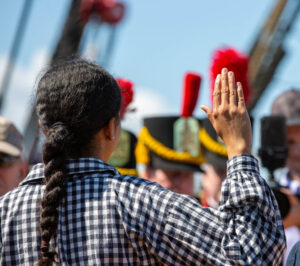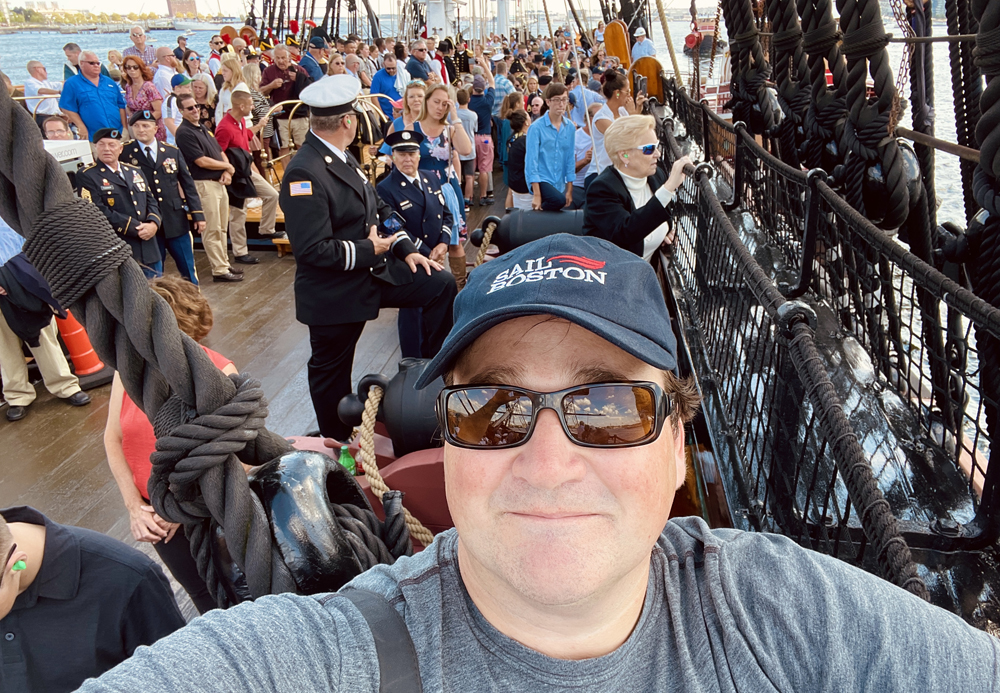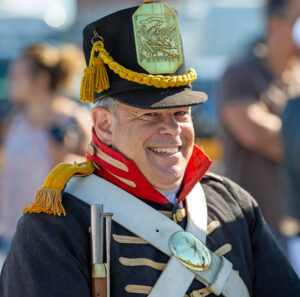True Tales from Canton’s Past: Huzzah
By George T. ComeauDr. Amos Evans was a young surgeon from Maryland. On June 11, 1812, at the age of 27, Evans found himself aboard the USS Constitution as she left the Washington Navy Yard and sailed to Annapolis. That was the day that Evans began keeping his journal as a private diary. Upon reaching Boston he “begrudgingly admired Boston’s built environment.” That is to say that his journal recounts his observations that the streets were “narrow and crooked, but well paved and clean.”
“The houses,” he writes, “have an air of neatness about them that in my opinion surpasses Philadelphia or Baltimore.”
Having this firsthand account from Evans is a gift. His opinions were percipient and well informed. During the famous battle between the HMS Guerriere, Evans wrote in a relieved tone that the casualties were light. “Seven men were killed in the action, including First Lieutenant William Sharp Bush of the Marines. Shot through the head while preparing to board Guerriere, he died instantly. In his haste to load his gun, Seaman Robert Brice forgot to sponge out the bore to extinguish the smoldering remains of the previous cartridge. As he rammed down the next charge, the cartridge exploded prematurely, killing the young sailor. Seamen James Ashford, John Brown, James Reed, Jacob Sago, and Caleb Smith all perished in the battle.” The USS Constitution is not only a great ship, she is also a war memorial and sacred battlefield.
Canton is part of the Constitution’s rich history. The original masts for this great ship were purportedly harvested from Elm Street. And “Old Ironsides” gets part of her moniker from the oak hull coppered soundly below the water line. USS Constitution’s lower hull was first coppered in the spring of 1797, a few months before she was launched from Edmund Hartt’s shipyard in Boston’s North End. The original copper was manufactured in Great Britain. By 1803, when she was re-coppered before her departure for the Mediterranean Sea as a flagship, Paul Revere’s new rolling mill here in Canton, Massachusetts supplied the second set of copper sheets.
Evans would have known of the copper sheets being produced by Paul Revere and had more than a casual interest in the operation. Evans’ father, John, had played a role in the American Revolution. During the war, the elder Evans provided tanned hides to make cartridge boxes and belts, sword scabbards and shoes, caps and straps, and a whole host of other essential items. After the war, John Evans began to manufacture nails and bar iron from the neighborhood’s rich ore deposits. At the time, there was but one great manufactory rolling copper sheets in America, and Evans wanted to see the Revere mill and report his observations to his father.
On October 19, 1812, Evans rode to Canton to visit the rolling mill. Evans wrote an extensive letter describing the arrangement of the mill and the process for rolling the copper, but apologized that “time would not allow a more minute examination into the process.” Both the letter and the diary entry are preserved: “Rode out to Paul Revere and Sons Rolling Mills, beyond Canton, 17 miles from Boston on the Taunton and Newport (R.I.) road. They have a furnace for smelting and refining copper pigs, and casting bells, cannon etc., and a mill with which they roll the copper like plates. There is another mill for the purpose of boring cannon. I was treated with much politeness by Mr. Eyres, one of the firm.”
While the diary entry is short, the letter to his parents is four pages long and very detailed. Evans describes the Canton property and the process closely. “The rolling mill has a head and fall of 13 feet and has two wheels. The stream is not large, nor does the particular circumstance of the original purchase allow of an extensive surface of water in the dam.” The letter details the rollers, the furnace, the arrangement of the flues and so many other details. Evans’ visit to Canton also included a walk downstream “to the Cotton Factories.” And a short description of the travel that day: “The country between Boston and Canton is hilly and rocky, but in a much higher state of cultivation than I had expected to find.”
At age 11, my parents brought me to Boston to watch the celebration of the Tall Ships as part of Operation Sail ’76. We all went out to the end of the runway at Logan Airport and spent the day watching the spectacle of ships. With only vague memory, I can absolutely say that that was the day I wished I had been aboard the USS Constitution as she led the flotilla. So many ships — barkentines, brigantines, hermaphrodite brigs, topsail schooners, coasting and sailing schooners and seagoing cutters — all within site of the Boston skyline. My love for tall ships was born that day.
Fast forward to July 1, 2021, and my career bringing me into a work project that involved Commander John Benda, the 76th commanding officer of the USS Constitution. I had met CDR Benda a few time over the years, but this was the time I shared my childhood dream of sailing aboard the famed vessel. Without hesitation, CDR Benda said that he could “make it happen.” The date set was September 11 on the occasion that celebrated the living Medal of Honor recipients who were in town for their convention. The day was also sacred for the memory of those lost in the attacks on America 20 years ago.
Alongside, I selected a high school student and friend from Newton who is precocious, animated and quite destined to parlay his love of American history into future success. Griffin, only 16 years old, knew as much about the Constitution as anyone in my historic circles. Seeing and sharing this opportunity through the eyes of a young and intelligent student was a dual gift for me. We arrived early at the Charlestown Navy Yard and neither of us had likely slept soundly the evening before. Excitement was palpable as the Navy prepared a shoreside memorial for 9/11 before embarking on a voyage to Castle Island.
A full police motorcade accompanied three MBTA busses with the Medal of Honor recipients as passengers. State Police helicopters buzzed overhead. Generals, admirals, captains and all branches of the military (including the Space Force) were in attendance. Alongside the ship was a Coast Guard security detail and Boston Police and Fire boats. Security was appropriately tight. Griffin and I made our way up the historic gangway and joined a few hundred other guests as the U.S. Navy made the ship ready for departure. As the ship bell rang, Griffin reminded me (and CDR Benda!) that in 1849 Pope Pius IX had been aboard. We walked the same decks, although likely refurbished, that the Italian Prince of the Church had graced on the first visit by a pope to the sovereign territory of the United States.

A crew member aboard the USS Constitution was sworn in as an American citizen during the turnaround. (George Comeau photo)
The crew’s navy uniforms had now been replaced with “authentic” period uniforms and we slowly slid from the berth as hundreds watched from shore. It felt special, because it was history coming alive. This is why we preserve our buildings, artifacts and relics of the past. To experience the Constitution as it moves through Boston Harbor is transformational. At 11:15 a.m., Massachusetts Air National Guard F-15C Eagles flew in formation high above the ship. Turning towards Castle Island, CDR Benda began narrating the details of the fight between the HMS Guerriere and the Constitution in 1812 off the coast of Halifax, Nova Scotia. The crew ran up the deck and the marines looked the part. Huzzah was heard more than once. The music of the 1812 Overture rang out through the sound system. Griffin and I had a place below deck within 10 feet of the large ceremonial cannons at the stem of the ship. As CDR Benda brought the recitation of the battle to a climax, a 21-gun salute rang forth and we were surrounded by smoke and powder. In answer, howitzers fired from Fort Independence in retort to our salvos.
The day was a blur and quite dreamlike — gorgeous weather, somber undertones, military precision and the re-telling of glorious heroics. It was a day made more memorable by the fact that we were on one of the most historic battlefields in American history. As we turned back towards Boston and approached Charlestown, a wreath was laid in memory of those men and women who perished in our many battles. Gazing from the stern, the wreath floated against brilliantly calm water. Almost alone, the memory of being 11 years old came back and the realization of a childhood dream. Canton has such a special and lasting connection to the USS Constitution and people like Dr. Evans who shared in being participants and witnesses to history.
Special thanks to Commanding Officer John A. Benda for his kind assistance.
Short URL: https://www.thecantoncitizen.com/?p=76978












